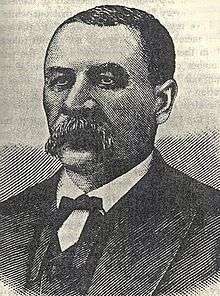Isaac Myers
| Isaac Myers | |
|---|---|
 Isaac Myers, pioneer of the African-American trade union movement circa 1875. | |
| Born |
January 13, 1835 Baltimore, Maryland |
| Died |
1891, Age 56 Baltimore, Maryland |
| Nationality | American |
| Occupation | Caulker, trade unionist |
| Known for | African American labor organizing |
Isaac Myers (January 13, 1835 – 1891) was a pioneering African American trade unionist, a co-operative organizer and a caulker from Baltimore, Maryland.[1][2][3][4][5]
Myers was born as a free black, though Maryland was a slave state. Since the state of Maryland did not offer public education for African American youth. Myers had to acquire his early education from a private day school run by Rev. John Fortie.[6] At the age of 16 he began work as a caulker, sealing seams in ships. In the 1850s Myers married Emma V. Morgan, who died in 1868. With her they had three children, including political activist George A. Myers.[2] He later married Sarah E. Deaver.[1] In 1860, Myers left caulking to work in a grocery business leading him to set up a short lived co-operative grocery in 1864. He returned to caulking in 1865.[1]
After the American Civil War competition for jobs led to strikes and protests by white workers, forcing over 1000 black caulkers to lose their jobs. Myers proposed the workers collectively pool resources and form a co-operative shipyard and railway, the Chesapeake Marine Railway and Dry Dock Company, to provide themselves with employment. The co-operative, opening in February 1866, was initially a great success, employing over 300 black workers.[1]
Myers and others also established the Colored Caulkers Trade Union Society in 1868, to which he was elected President.[3] The National Labor Union took interest, inviting the Colored Caulkers Trade Union Society to their annual convention. The move was significant for what had previously been an all-white union, but black workers continued to face opposition to membership. In response the Colored National Labor Union was established in 1869, with Myers as President. He was succeeded in 1872 as President by Frederick Douglass.[4][7]
Following his departure from the CFNL Myer's continued working and contributing to the labor movement. He became increasingly involved in the Republican Party during the 1870s. Working as both a Customs Service agent and as a postal service agent under Lincoln, before returning to operate a coal yard in Baltimore. "Myer's also organized and became President of the Maryland Colored State Industrial Fair Association, the Colored Business Men's Association of Baltimore, the Colored Building and Loan Association, and the Aged Ministers Home of the A.M.E. Church".[8]
The Frederick Douglass - Isaac Myers Maritime Park in Baltimore is named after Myers.[9]
References
- 1 2 3 4 Carney Smith, Jessie, ed. (2006). "Isaac Myers (1851 - 1891)". Encyclopedia of African American Business, Volume 1. Greenwood Publishing Group. p. 551. ISBN 0313331103. Retrieved 29 December 2014.
- 1 2 "MYERS, GEORGE A. - The Encyclopedia of Cleveland History". The Encyclopedia of Cleveland History. Retrieved 29 December 2014.
- 1 2 Heung, Camille. "Myers, Isaac (1835-1891)". BlackPast.org. Retrieved 29 December 2014.
- 1 2 Kutler, Stanley I., ed. (2003). "Colored National Labor Union". Dictionary of American History. Retrieved 29 December 2014.
- ↑ "Isaac Myers: Pioneer of the African-American Trade Union Movement". American Postal Workers Union. Retrieved 29 December 2014.
- ↑ "Myers, Isaac (1835-1891) | The Black Past: Remembered and Reclaimed". www.blackpast.org. Retrieved 2015-12-03.
- ↑ "Today in labor history: Black workers form national union". People's World. Retrieved 29 December 2014.
- ↑ "Myers, Isaac (1835-1891) | The Black Past: Remembered and Reclaimed". www.blackpast.org. Retrieved 2015-12-03.
- ↑ "About Us". Frederick Douglass - Isaac Myers Maritime Park. Retrieved 29 December 2014.